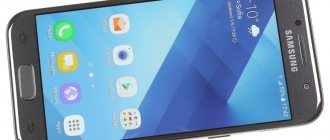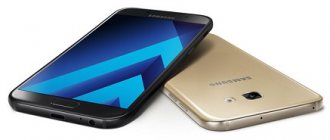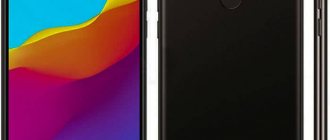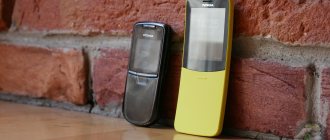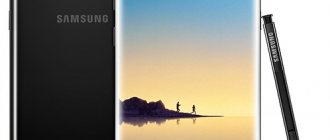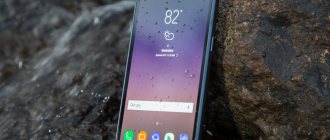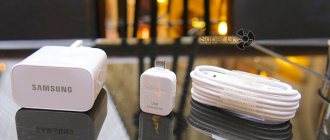Budget devices of the Samsung Galaxy J line rarely come into our field of vision - they have little interesting in comparison with their older brothers and we buy them primarily because of the brand. But there are exceptions to every rule, and today we will get to know one of them. The J5 Prime is a compact device with a nice design, but the smartphone offers more than just a pretty package.
Samsung Galaxy J5 Prime (2016) Black (SM-G570FZKD) Smartphones and mobile phones on
Notify when on sale
Design and usability
Samsung J5 Prime can make a good impression at first glance, without even picking it up. A little unusual, but they decided to make its body mainly from metal, and the front panel is decorated with glass with rounded edges. We've seen this before, but it's new to the Galaxy J line. The edges of the switched-off screen merge with the black front panel, which also adds value to the appearance.
The second nice feature is its relatively compact size. The screen frames are certainly not minimal, but the display itself is 5 inches, and the corners of the body are slightly rounded, so the J5 Prime feels small in the palm of your hand - you can handle it with one hand without any problems.
The smartphone is available in two body colors - dark blue and gold. We got the first option. The front panel looks as laconic as possible; only the designations of the touch keys, the speaker grille, and the indicator of missed events stand out on it.
The “back” looks interesting; the color of the plastic inserts on top and bottom matches the metal cover and looks better than banal black, although the camera design is reminiscent of the company’s old push-button phones.
There are no complaints about the assembly, everything is adjusted as precisely as possible, and the control scheme and arrangement of elements will be familiar to any user of Samsung smartphones.
There are three keys under the screen: two side touch keys without backlight and a central mechanical one. With its help, you can turn on the screen backlight, answer a call, and double-click to launch the camera. You quickly get used to this and begin to regret that such options are available in a minimal number of other smartphones.
In addition, the mechanical key boasts a built-in fingerprint scanner. It allows you to save up to three fingerprints, works quickly, but does not always recognize your finger the first time - in expensive Samsung devices the sensor works better.
MicroUSB and 3.5 mm connectors are located at the bottom. There is a single microphone nearby. On the right you can find the power key, and separate volume buttons are placed on the left side. They are a little higher than we would like.
There are two whole trays underneath them. The main NanoSIM is installed in the upper one, and the second SIM card (also Nano format) and a memory card are installed in the lower one. Such a wealth of slots will definitely be appreciated by those who are used to using two SIMs and a memory card, because new smartphones are increasingly using hybrid slots.
The only speaker is located above the power key on the right. The unusual location of the speaker turned out to be quite successful - compared to placement on the bottom edge or back, it is less likely to be blocked by hands while watching videos and games, while notification signals are clearly audible from pockets.
Appearance
As we already said, the Samsung Galaxy J5 Prime 2020 has undergone design changes compared to the 2020 model. What are the differences? The new Samsung Galaxy G 5 Prime has a metal body, unlike the previous one, which had plastic. Because of this change, the smartphone has become quite weighty. It feels very nice in the hand. It feels like you are holding some kind of monolith.
The G5 Prime 2020 has had the Super Amolled screen removed and now PLS TFT technology is installed here. The display already has a film pre-installed out of the box. The display diagonal is 5 inches with a resolution of 720 by 1000 pixels. There are no problems with viewing angles. The screen is bright. Multi-touch is calculated for five simultaneous touches.
On the right side there is a power button, on top there is nothing. On the left are the volume buttons, a slot for a memory card (the card is supported up to 256 GB) and two slots for Nano-sized SIM cards. It’s nice that now you don’t have to choose: 2 SIM or 1 SIM and 1 memory card. All slots are independent, which is a little unusual now. SIM card slots open and pull out easily.
At the bottom you can find a 3.5 mm jack for standard headphones and microUSB, a microphone. On the back there is a camera and flash. The camera is beautifully stylized and does not protrude, which is good news.
The front part looks very stylish and beautiful.
Many users like rounded glass, given the fact that not everyone likes to stick films and glass onto the display.
The bottom key at the bottom of the front part is not only a mechanical button, but also acts as a fingerprint scanner. Unfortunately, it does not return back, unlike the A-series models.
Read also Review and characteristics of Samsung Galaxy A5 2017 (Samsung Galaxy A5)
From the tactile sensations, there is a feeling that you are holding a Samsung flagship in your hands, with the exception of little things and nuances that you won’t immediately notice; they are not visible at first glance.
I would like to note the sound of the smartphone. It has a very deep velvety sound that you want to listen to for as long as possible. It doesn't hurt the ear in any way. The speaker is of high quality, but is located in a non-standard place - above the power button. On the one hand, this is an interesting solution, but on the other hand, it happens that sometimes the user covers this speaker with his finger, so it is better if the speaker is located at the bottom.
Screen
Samsung began installing their own Super AMOLED displays even in inexpensive smartphones, but in the J5 Prime they decided to use a PLS matrix. You can think about the reasons for making such a decision and some strangeness, but it’s hard to find fault with the quality of the display itself.
Diagonal 5 inches, resolution 1280 by 720 pixels. The brightness varies from 3 to 332 cd/m², the measured contrast is 1 in 743. There is an additional “outdoor” mode, which is activated directly from the notification panel - in it the brightness increases to a maximum of 402 cd/m². The device does not have an automatic brightness adjustment sensor - you have to adjust it manually.
The screen is not perfectly calibrated, but overall it is good, so color reproduction is natural. There is no air gap, there is a nominal oleophobic coating, plus do not forget about glass with a 2.5D effect.
Therefore, in real life the screen leaves a positive impression - it has a calm and pleasant smooth picture, good readability in the sun (on a cloudy autumn day you don’t have to activate the “outdoor” mode). Of course, you can find fault with the lack of a proprietary AMOLED and color mode settings, or the resolution, but personally, the only thing I was missing was an auto-brightness sensor - habit takes its toll, especially since in normal devices they work adequately and there is the possibility of additional adjustment.
Galaxy J5 Prime 2020 - comparison with Galaxy J3 (2017) and Galaxy J5 Prime (2016)
Now let’s take a quick look at the hardware parameters of this year’s Galaxy Jay 3 Prime and last year’s Jay 5 Prime to find out how much our device has grown relative to its predecessor and the same age, but junior in rank. Again we present a comparative table with characteristics, followed by a short conclusion.
| Galaxy J5 Prime 2016 | Galaxy J3 Prime 2017 |
|
|
Let's start with the predecessor Galaxy J5 Prime 2020. In fact, there are very few differences: they reduced it here, trimmed it there - it’s logical. Among the major changes, we can only highlight a decrease in the resolution and aperture of the front camera and a serious drop in price to 9,500 rubles. That is, with almost identical parameters, the Galaxy J5 Prime 2020 costs 1.5 thousand rubles less. At the same time, the body of the new 2020 product has become better and more pleasant, and for many users this is a critical indicator. Conclusion: either we save our money and get a plastic case, or we don’t skimp and pay an extra 1.5K for more premium materials.
Now a few words about the Galaxy J3 Prime 2020. Honestly, you can’t look at this device without tears. Who else would think of installing 1.5 GB of RAM in 2020? The cameras are also a disaster and they are not good for anything, at most for video calls. Even on Instagram, it’s a shame to upload photos from the Galaxy J3 Prime 2020 - filters cannot hide, to put it mildly, the mediocre quality and detail of the pictures. At the same time, the cost compared to the Galaxy J5 Prime 2017 is still normal, but compared to the market it is huge. Finally, the body of the younger representative of the line is entirely made of plastic, which is very disappointing. Conclusion: it is strictly not recommended to buy a smartphone under any pretext.
Hardware platform and performance
Galaxy J5 Prime is built on the new SoC Exynos 7570, made in compliance with 14 nm process technology. The platform includes 4 Cortex-A53 cores operating at 1.4 GHz and Mali-T720 graphics. The smartphone has 2 GB of RAM and 16 GB of storage, which can be expanded using a separate MicroSD slot.
In terms of performance, you should not expect outstanding results; the processor does not set any records in benchmarks, but the operating speed is enough to talk about comfortable use in everyday tasks. Launching and switching between applications, Chrome, YouTube - all this is not lightning fast, but fast enough not to cause irritation.
The situation with games is average; a lot will depend on optimization, since the platform is new. Now there are no problems with casual toys, but more complex ones are average. For example, with Need for Speed: No Limits everything is fine, but Asphalt 8 comes with slowdowns, the controls do not work very clearly.
Processor, OS and battery
The Samsung Galaxy G 5 Prime 2020 has a quad-core Exynos 7570 processor with a clock frequency of 1.4 GHz. RAM - 2 GB, built-in - 16 GB, but in the end only 10 GB will be available to the user, which is already quite good. Moreover, if this memory is not enough for you, then you can safely insert a MicroSD without losing one SIM card. The phone runs on Android 6.0.1.
Already out of the box, the J5 Prime will have in its arsenal not only Google and Samsung applications, but even from Microsoft. The shell works quickly, no lags were observed during use.
Unfortunately, the processor here is rather weak. Software tests do not show the best results. Games also prove this when launching; you have to greatly reduce the settings to get a more or less smooth picture.
Compared to the classic J5, the Prime version has a slightly smaller battery. It is now at 2400 Milliampere/hour. Which for the given processor consumption is quite enough for comfortable work. Autonomy is at a high level, that is, without charging the device can be used for 2 days and 15 hours. This is a big plus.
Read also LG v30 plus review and specifications - Video
Of course, if you load your smartphone full of games and watching videos, the battery will drain much faster. If you use the device for calls, photos and social networks, then, in principle, the charge will last for a considerable time.
Working hours
If performance can be considered comparable to previous generations of smartphones, then over time there are noticeable changes for the better.
The built-in battery has a modest capacity of 2400 mAh, but thanks to the updated hardware platform, the J5 Prime lasts much longer than expected. In the synthetic test, we managed to get a result in almost 10 hours. In real use, the smartphone worked for a day and a half, showing 8 hours of active screen.
The usage pattern was standard - synchronization of two Google accounts, social networks, correspondence in instant messengers, watching videos (local and YouTube), accessing the Internet via Wi-Fi and 3G. The result is good, and if you use your smartphone less actively, you can count on two days of work.
Camera Features
The Galaxy J5 Prime smartphone has the same camera as the 2020 J5 and J7 models, as well as the more expensive high-end Samsung Galaxy A5, which gives hope for good quality. The resolution of this camera is 13 megapixels, the aperture is f/1.9.
The camera interface is standard for many of the latest models from the South Korean manufacturer. All icons with performance settings are grouped on one side of the screen, and the photo and video camera icons, along with the gallery and the “Shutter” button, are on the other. There are several modes for the user to choose from. These are, for example, panorama, series, sports, night mode and HDR. The effect of the latter, by the way, is really noticeable when shooting, which is not so often observed even with phones even of a higher class. And the panoramas shot with the J5 Prime camera are pleasing with the level of detail, the overall quality of the image and, what is important, completely invisible places of gluing.
In addition to preset modes, the phone allows the owner to independently configure shooting parameters. You can adjust the exposure yourself, set the desired exposure value, and also adjust the ISO level.
Daytime shooting
In daylight and sufficient lighting, the camera produces very decent images with excellent detail and maximum clarity. Color rendition is very close to the original gamma, the camera adjusts the white balance extremely accurately. In addition, the brightness of the resulting images and the richness of the colors in the photo also leave only pleasant impressions. It is also worth noting the good autofocus speed.
The quality of daytime images, as you can see, is excellent
Rich colors, maximum detail, no fuzzy fragments
However, the situation changes slightly even in a well-lit room with daylight - moving objects take on fuzzy outlines
The camera on the Galaxy J5 Prime sometimes overexposes the space - if the light source is in the background, there is a high probability that the foreground will fall into darkness
However, it’s easy to get used to such nuances
Macro mode on the Galaxy J5 Prime also produces good results in sufficient lighting conditions
The photos are rich and detailed
White balance is adjusted very accurately, and color rendition is pleasant and natural
Night photography
As often happens with budget and mid-range cameras from Samsung, problems begin after dark. As soon as the phone begins to lack available lighting, various noises and blurriness appear in the pictures. The camera instantly loses all its positive qualities and turns into a simple point-and-shoot camera. Autofocus often starts to act up and slows down noticeably, moving objects in pictures look like blurry spots, and the overall picture is quite unsightly. For the sake of a decent result, you can, of course, take several frames at a time, point the lens exclusively at static objects and take the most stable position of your hands. But, you must admit, it’s not always possible to dance with your phone to take a good photo.
As the available light decreases, the quality of the images decreases. You can see how clear the left side of the photo seems and how noisy the right side seems. Moving objects will have to be photographed with great patience and dexterity. In the case of static ones, everything is a little easier, but you can’t avoid noise. Most of the first photos will look that’s right - blurry edges and an unsightly picture. By the way, due to the features of the PLS matrix, you may be a little upset by the color rendering of black. Blacks look more saturated in AMOLED
Front-camera
The front camera on the J5 Prime has a resolution of 5 megapixels and an aperture with a light sensitivity of f/2.2. The front camera of the phone is expectedly worse than its partner on the other side of the body. Faces in selfies look somewhat blurry; you can’t expect much detail or richness from the pictures. During the day the result is quite passable, but in the evening or in poor lighting the quality decreases significantly.
Among other things, the developers have included a wide-angle selfie function here, which slightly increases the camera’s field of view and makes the process of taking an image even more comfortable.
What about the video?
The video is recorded in Full HD quality with a resolution of 1920 x 1280 pixels and a frame rate of 30 fps. In comparison with the pictures, the quality of the videos is pleasing both when shooting with the main camera and with the front one. The time of day and illumination also have little effect on the picture - the quality does not deteriorate, the brightness and saturation do not subside, and the detail maintains its level.
In general, the phone's camera behaves quite standardly not only for the economy class, but also for the lower middle class from Samsung. During the day, you can easily take pictures and not worry about the quality of the pictures - they will definitely be good. But in the evening you should give preference to a camera or other more powerful equipment.
Shell
The smartphone runs Android 6.0.1 with TouchWiz shell. It supports design themes, installing fonts from the built-in store, and has an average number of pre-installed applications.
Separately, we can note the relatively restrained interface design and convenient “dialer” and calendar.
Cameras
J5 Prime offers a main camera with a resolution of 13 megapixels and f/1.9 aperture, as well as a front camera of 5 megapixels (f/2.2). The maximum video recording resolution is 1920 by 1080 pixels (for both cameras).
In addition to the usual automatic mode, the camera has panorama, burst, HDR, night, and sports modes. Pro mode allows you to adjust white balance, ISO, exposure compensation and exposure metering method, without the ability to manually focus.
Overall, I was pleased with the main camera - during the day it allows you to take pictures with natural color reproduction and good detail; the frames look good both on the smartphone screen and on a PC. Along with the deterioration of shooting conditions, the quality decreases linearly - focusing takes noticeably longer, sometimes autofocus misses and some photos are not sharp. Therefore, indoors or in the evening, it is better to take several shots and choose the best one, try to shoot static objects.
The cameras of even some more expensive devices behave in a similar way, so there is nothing criminal about this.
The situation is similar with the front camera - it takes good pictures during the day and is mediocre indoors. Wide-angle optics are used, it is possible to correct skin tone and facial contours.
4.5
ITC.UA rating
Pros: design and materials of the case; good PLS screen covered with 2.5D glass with oleophobic coating; modern platform providing normal speed and excellent operating time; separate slots for two SIMs and a memory card; normal cameras; Fingerprint's scanner; price
Cons: no auto-brightness sensor; touch keys without backlight; the scanner does not always recognize fingerprints the first time
Conclusion: I was pleased with the J5 Prime - the company has created an inexpensive, beautiful and pleasant device for everyday use. In Ukraine it will be sold for 5,499 hryvnia and, taking into account all the advantages, the price can be called competitive. We advise those who prefer devices from well-known companies, but do not have a huge budget, to take a closer look at the J5 Prime.
Specifications
| Samsung Galaxy J5 Prime (2016) Black (SM-G570FZKD) Notify when available | |
| Type | Smartphone |
| Pre-installed OS | Android 6.0.1 |
| RAM, GB | 2 |
| Built-in memory, GB | 16 |
| Expansion slot | + |
| SIM card type | Nano-SIM |
| Number of SIM cards | 2 |
| CPU | Samsung Exynos 7570 + GPU Mali-T720 |
| Number of Cores | 4 |
| Frequency, GHz | 1,4 |
| Battery | 2400 mAh (non-removable) |
| Diagonal, inches | 5 |
| Permission | 1280×720 |
| Matrix type | PLS |
| PPI | 294 |
| Dimming sensor | — |
| Display Features | 2.5D glass |
| Main camera, MP | 13 |
| Video shooting | 1080p, 30 fps |
| Flash | LED |
| Front camera, MP | 5 |
| Communication standards | GSM 900/1800/1900, WCDMA 900/2100, LTE FDD, LTE TDD |
| WiFi | 802.11n |
| Bluetooth | 4.1 |
| GPS | + |
| IrDA | — |
| FM radio | + |
| Audio jack | + |
| NFC | — |
| Interface connector | micro-USB |
| Height, mm | 142,8 |
| Width, mm | 69,5 |
| Thickness, mm | 8,1 |
| Weight, g | 143 |
| Protection from dust and moisture | — |
| Type of shell | monoblock |
| Housing material | metal, plastic |
| Keyboard type | screen input |
| More | accelerometer, gyroscope, fingerprint scanner |
Galaxy J5 Prime 2020 – review and specifications, price
Great review of Galaxy Jay 2/3/5/7 2020 | Preview of Galaxy A 2018
Smartphone Galaxy Jay 5 Prime 2020 is an inexpensive device that is designed to strengthen the position of Samsung in the field of the huge budget market from China. That is, the device is aimed at the audience that without hesitation purchases inexpensive smartphones costing up to $200, without delving into detailed specifications. In our case, the Galaxy Jay 5 Prime 2020 is a gadget from an A-brand with all the ensuing consequences.
Design
In total, the Galaxy J5 Prime 2020 model comes in two colors: gold and black. The body is made of durable aluminum alloy, but there is also plastic; it is available in the form of plugs on the rear wall at the top and bottom. However, this does not cause any discomfort, and if Chinese craftsmen have managed to achieve high quality performance of such cases, then the Galaxy J5 Prime 2020 has no problems with this at all. In front we are greeted by tempered glass and a fingerprint scanner - alas, next year all this may no longer exist, since Samsung has firmly taken the bezel-less path and the Galaxy A8 2018 is proof of this. In terms of dimensions, this is a compact smartphone with an average weight - it is convenient to use and fits well in the hand. By the way, unlike Chinese craftsmen, Samsung offers two slots in its smartphone to simultaneously install two SIM cards and a memory card - definitely a plus! The only negative that can be noticed in appearance and in parallel with the technical part is the outdated micro USB 2.0 port.
Display
Although Samsung is actively introducing and promoting AMOLED screens even in the budget segment, this type of matrix, unfortunately, bypassed the J5 Prime 2020. It has a 5-inch screen with a Samsung PLS matrix - worse than AMOLED, but better than the average IPS (but this is its analogue). Resolution 1280x720 pixels, pixel density 294 ppi, protective glass Gorilla Glass 4 (pre-top solution). The downside of the J5 Prime 2020 is the lack of a light sensor, although there are some brightness presets like “Outdoor”, etc. On the other hand, you shouldn’t strongly criticize the Galaxy J5 Prime 2020 for the lack of a sensor, since although it is a convenient thing, it is still better to adjust the brightness manually, since the automation is not averse to feasting on the battery charge, which already does not have a high capacity.
Processor and memory
The J5 Prime 2020 is powered by a quad-core Samsung Exynos 7570 chip with Cortex-A53 cores and a frequency of up to 1.4 GHz. The performance for such a solution is quite typical and the Antutu counter scored something in the region of 37,000 points. This is an acceptable indicator for any everyday tasks and not too heavy toys (the Mali graphics, of course, let us down). There is plenty of RAM for a device of this level - 3 GB LPDDR3, and storage varies from 16 GB to 32 GB, while it is possible to install memory cards in a separate slot, where without this.
Cameras
Samsung has always been famous for the high quality of photographs and camera modules, so it is not surprising that the Galaxy Jay 5 Prime 2020 has a good sensor and a light-sensitive lens. The resolution of the photo module is 13 MP and the aperture is f/1.9. The smartphone produces excellent photos for its budget, with high detail, rich colors and low noise. Given the lack of light, the J5 Prime 2020 is far from being a flagship, which is not surprising, but during the day it’s impossible to find fault with the quality of photographic materials.
Autonomy
Despite the very modest battery capacity, the Galaxy J5 Prime 2020 lasts quite a long time on a single charge. The reason for this is not the most powerful hardware (energy-efficient chip, small screen resolution, medium display diagonal, etc.), which modestly consumes battery energy. A 2500 mAh smartphone is enough for 2 full days of battery life, while the screen operating time is on average 10-11 hours, which is an excellent indicator. There is no fast charging, and at 5V/1A it takes about 2 hours to fill the battery from 0% to 100%.
Galaxy Jay 5 Prime 2020 - specifications and price
- Colors: black, gold;
- Housing: plastic, metal;
- Display: 5 inches, TFT PLS-matrix, 1280x720 pixels, 294 ppi, screen area 69.6, 16:9 format;
- Chipset: Samsung Exynos 7 Quad 7570, 4-core, Cortex-A53 up to 1.4 GHz, 14 nm process technology, 64-bit;
- Graphics: Mali-T720 MP1, frequency 533 MHz;
- RAM: 3 GB LPDDR3;
- Storage: 16 or 32 GB, memory card support;
- Camera: 13 MP, f/1.9 aperture, autofocus, HDR, Full HD video recording;
- Selfie camera: 8 MP, f/2.0 aperture;
- Number of SIM cards: two;
- Support 4G LTE Cat.4 - 150 Mbit/s, upload 50 Mbit/s;
- GPS, A-GPS, GLONASS, BeiDou;
- Wi-Fi 802.11 a/b/g/n, Bluetooth 4.2, Micro USB 2.0, 3.5 mm mini-jack,
- Fingerprint's scanner;
- Battery: 2500 mAh, non-removable, charging 5V/1A;
- Android 7.1.1;
- Size: 142.7x69.6x8.1 mm;
- Weight 142 g;
- Antutu: 37000;
- Price: 10990 rubles.
Today you can buy a J5 Prime 2020 in most stores in Russia for about 11,000 rubles (some are more expensive, some are cheaper). It’s impossible to say that this is a completely useless device; nevertheless, it has a good appearance, a good camera, enough memory, decent battery life, but very weak performance (especially for serious games). So it's a solid 4, with some reservations.

